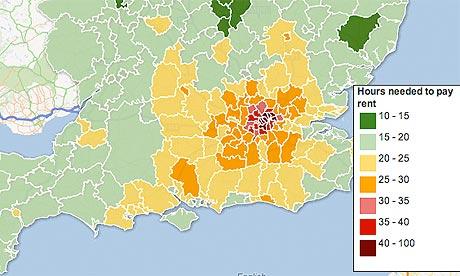
This visualisation shows for each council or unitary authority how many hours a week you’d need to work, earning minimum wage, in order to pay the median rent for a one-bed flat. The minimum wage is a national constant.
No justification is given for using the median rent. In a fair world, the median rent should be paid by someone on the median income. Assuming that people earning the minimum wage are the lowest earners ((this isn’t true: people earning cash in hand, for example, might earn less than the minimum wage but they still have an effect on house prices)) and make up X% of the population, then an upper bound for rent paid by people earning minimum wage should be the Xth percentile, if housing is provided fairly ((another large assumption.)). If you’re not paying attention to this kind of thing, you might as well just say “average” instead of “median”.
Finally, there’s this:
Note that these figures are dramatic simplifications, used for illustrative purposes only: in reality tax payments, tax credits, housing benefit, council tax, utility bills and more substantially alter these figures.
So the figures are meaningless anyway – benefits might be so generous that very little of the lowest earners’ pay goes towards housing, or taxes might be so high that people really need to work many more hours than this statistic claims in order to keep a house.
Supposing that all of these problems are sorted out and we calculate a reasonable-sounding number of hours to work to earn rent each week, what should that number be? What if house prices plummeted but food became very expensive? I can’t think what these numbers are telling us that raw rent data aren’t already.
A question has occurred to me: would I be making life worse for those worse off me by living in a flat cheaper than I should be or, on the other hand, would spending a higher than average proportion of my income on rent drive prices up, having an effect on the bottom end of the market? I suppose taking a cheaper flat reduces the prices of nicer ones. This is why I don’t like economics.
